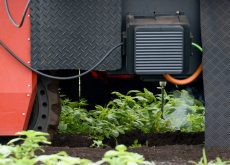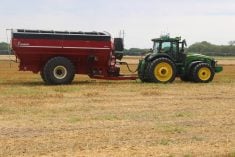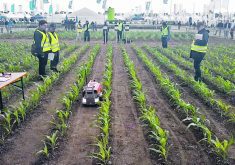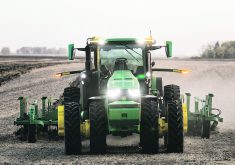Implements evolve to become bigger, heavier and more powerful. The downside of that weight is compaction, getting stuck and bigger horsepower demand.
Can the trend be reversed toward lighter implements?
Matt Hesse says it’s happening. He is a vice-president at Sabanto, a manufacturer of aftermarket autonomous systems for agriculture. Right now, it is focused on Kubota tractors in the 60 to 90 hp range.
“On one hand you have the expense of extremely big machines. Scaling of farm equipment has traditionally been upwards,” said Hesse in an online interview.
Read Also

Gene editing digs deeper space in Canadian plant breeding
More Canadian research into crop variety development is incorporating gene editing, and one researcher notes that Canada’s regulatory approach to gene editing will help drive innovation
Hesse: “What happens if we scale down to smaller, lighter, lower horsepower tractors, but more of them? It’s the swarm concept. Replace a 600-horsepower tractor with a half dozen smaller autonomous tractors all working according to their prescriptions.”
Western Producer: Prairie farmers support the autonomous concept but they are farming 5,000 to 30,000 acres. They need 600 horsepower. An autonomous tiny horsepower tractor might be useful for haying or harrowing or managing headlands, but what’s the fit for broad scale, broad acre farming?
Kyle Dulia (Sabanto): Down in that 60-90 horsepower range, with four- or five-ton tractors, we can deploy the same amount of horsepower to the field. We can swarm four or five autonomous units. But in the end, it might be only from two or three 200-horsepower tractors. Then these ideas start to make sense. There’s a happy medium there.
The machinery paradigm might not necessarily shift in the direction of swarm small tractors immediately. But once people realize they don’t need another operator, then adding more small machines makes sense in terms of compaction, fuel economy and capital efficiency, especially if you’re looking to reduce compaction.
Western Producer: But with four smaller tractors, farmers would have to buy four cultivators, four air drills and maintain them all.
Dulia: Yeah, true. We are introducing complexity. At the same time, we’re also bringing in resiliency. What happens when your 600 horsepower Quad pulling a drill goes down? Now you have zero percent productivity. With the swarm configuration, a problem with one machine lets you continue at 75 percent productivity.
Mud is another factor. There’s the agronomic advantage in getting on the field with your drills sooner with smaller implements.
There’s a tremendous effort making those big drills fold and push seed and fertilizer out to the ends 50 feet from the centre, and then you expect them to place seed accurately. Functioning on this massive scale requires a lot of time, money, power and complexity.
Think about downsizing that implement to something like 36 feet and hooking them to smaller tractors.
Western Producer: It’s not uncommon for a new tractor and drill to approach the $1.5 million mark. How many smaller swarm units could a person buy for that money?
Dulia: We’ve done some work on the economics. It’s actually more favourable than you’d think. Implement width is dimension you need to grow to have greater productivity per hour. That’s the element farmers are concerned with.
So if you’re bigger in width, you’re paying for more steel. The cost increase is exponential as your drill and tractor grow. But what happens if you start to scale down? The numbers scale down quite nicely.
For example, a 600 horsepower Quadtrac, 20-ton tractor carries a price tag of about $750,000. If I want to deploy the same amount of horsepower in the field, I can use maybe five or six autonomous Kubota M5s.
They list for about $60,000. So just the capital cost of the tractor is a 40 plus percent capital reduction.
You still have to buy planters or seeders. That’s substantially the same cost-reduction story. The large scale seeders are big, they’re wide, they’re heavy and they’re expensive. High-speed disc drills have come a long way in recent years. They’re compatible with lower horsepower tractors. The combination lets you seed two or three different fields at the same time without hiring extra people.
There’s some good compatibility with this scale-down idea. If you’re not constrained by needing to hire operators to drive these things, the machine paradigm changes.
Hesse: In the testing we’ve done the last two years, we’ve had cultivation work going on 48 consecutive hours. We just tended to it with fuel. We slept through the night while it was still out there operating. On one test we planted over 750 acres with a single unit running continuously, just tending to it.
Western Producer: So it’s more a management concept you’re promoting rather than new technology?
Hesse: The Sabanto technology stack is quite straightforward. You have onboard technology which enables the machine and we have our off-board cloud platform where the customer interacts with the machines.
Onboard components are largely off-the shelf. This includes GPS receivers, cameras, obstacle detection, cellular communications plus hydraulic valves and hoses. We didn’t see any need to re-invent things when these components are commoditized and manufactured by trusted people who’ve been in the business for some time.
The linchpin in the on-board stack is our Sabanto-designed control unit. This integrates all the on-board vehicle sensing and control with communication to and from our cloud-based mission control software.
Mission control is where the customer interacts with all their vehicles and implements operating out in the wild. It’s cloud-native, available from any computer or mobile device. And it’s built from the ground up as brand-agnostic. It provides customers with the situational awareness of their fleet’s operations and the ability to task and command those vehicles at will. It does this while providing a data collection platform that enables them to share and do business with their preferred partners.
Western Producer: Does your system plumb directly into the hydraulic systems or do you connect directly to the master controller?
Dulia: It depends on the application and the integration for different tractors. Each tractor has its own needs. Something like an M5 requires actuators, brakes and hydraulics. On the Kubotas, we add a steering valve and there’s some plumbing work.
But a modern Can-based tractor doesn’t need a lot of additional hardware. Tractors like the Fendt 7900, Magnum, Quadtrac or an 8R are more plug and play. They have electro-hydraulic remotes and CBT transmissions. They’re guidance ready.
Western Producer: There’s nothing new about guidance. How does your system differ from the latest generation systems coming to market?
Hesse: Well, it’s a bit of apples and oranges. So let’s break it down. You’ve got auto-guidance systems like Outback, Ag Leader, Trimble and others. What does it take to create auto guidance? You have a steering valve, a steering sensor, a brain box and a display. So that basically makes up the auto-guidance system.
The autonomy side is similar. You still control a steering valve, whether you add it or use OEM. You still have a steering sensor. We use a receiver that tells where the tractor is and which direction it’s pointing.
It has dual antenna on the roof. We also have cell phone antennas, so it’s always communicating through the cell phone network. We have cameras on the front, sides and the back. Plus we have sensors out front for obstacle detection. Finally, we have LIDAR. So basically, we’ve taken an auto guidance kit and added more sensors.
The thing that we don’t have is a display. The missions and planning are set up through a phone, a tablet or a computer. We have the ability to remote start the tractor and lay out the whole mission. You basically hit play from your phone and it does the task at hand.
In the 20-year-old semi-automatic guidance operation, you still had somebody in the seat. The Sabanto application removes the person from the seat and converts your existing tractor into a fully autonomous farming system.
Western Producer: How many units do you have out in the field now and do you have anything going on in Canada?
Dulia: We do have a dealer signed in Eastern Canada and we’re looking for a dealer in Western Canada. Keep in mind this is brand new. We only just launched the product. We’ve delivered a couple units to the U.S. military. Our engineers have had half a dozen running at one time. We’re looking to deploy dozens of units in the local area here in springtime.
To date, Sabanto Kubotas test units have autonomously tilled, planted, seeded, weeded, applied, and mowed across Illinois, Iowa, Indiana, Missouri, Nebraska, Minnesota, North Dakota, Wisconsin and Texas.
Western Producer: Can you give a price range with a purchase and a subscription?
Hesse: The farmer owns the hardware. We charge an annual subscription for the command and control and for additional features that are delivered as we continue to develop. Price is going to be in the ballpark of something south of $100,000.
Think of it like this. It’s pretty easy to spend $100,000 on a pickup truck, and that truck is about as productive as a car driving you up and down the road. Maybe 20 percent of the time it’s actually doing some work for you. An autonomous tractor can be productive 24 hours a day, seven days a week.
Right now the kit is only available for Kubota, but we’ll be expanding to other brands and more powerful tractors. Long-term, we’re looking at sprayers and combines.
















